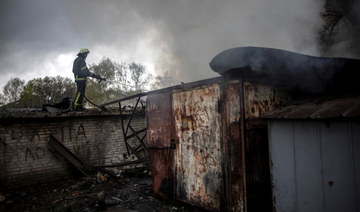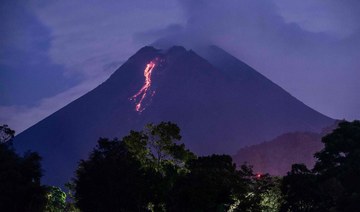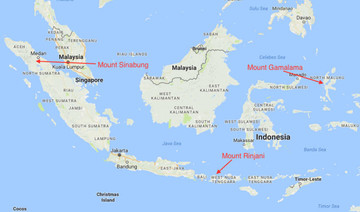KYIV, Ukraine: Pro-Kremlin authorities in Ukraine’s Kherson said Wednesday they will ask Russia to annex the region as Moscow seeks to shore up its gains in the increasingly drawn-out and bloody war.
Gas supplies to energy-starved Europe were also disrupted by a halt in Russian supplies flowing through Ukraine as the international shockwaves of the February 24 invasion continued.
The developments came as Ukraine said it was pushing Russian troops away from the country’s second city Kharkiv in the northeast but facing stiff resistance from the invading forces.
Russia has focused on eastern and southern Ukraine since it failed to take Kyiv in the first weeks after the February 24 invasion, and US intelligence has warned Putin is ready for a long war.
Kherson, the first major Ukrainian city to fall after the Russian invasion of its pro-Western neighbor, is north of Crimea, which itself was annexed by Moscow in 2014 after an internationally-condemned vote.
Kirill Stremousov, deputy head of Kherson’s Moscow-installed civilian and military administration, said there would be a “request to make Kherson region a full subject of the Russian Federation.”
Stremousov suggested the authorities would appeal directly to Putin without putting the move to a vote. But the Kremlin replied that it was up to the residents of Kherson to “determine their own fate.”
Kherson is just north of Crimea and essential for its water supplies. But Russia also appears set on creating a land bridge to Crimea from its own territory, with US intelligence suggesting it wants to go all the way across the southern coast to Moldova.
On the battlefield, Ukraine’s forces were boosted by what Kyiv says is the recapture of four villages around Kharkiv.
President Volodymyr Zelensky said in his nightly address Tuesday that he had “good news” from Kharkiv and praised the “superhuman strength” of Ukrainian defenders.
Ukraine’s general staff of the armed forces said Wednesday that “occupiers continue to focus their efforts on preventing the further advance of our troops toward the state border of Ukraine” from Kharkiv.
But Ukraine is engaged in what appears to be an increasingly desperate effort to hold the Russian-speaking Donbas region in the east.
“They come in waves,” volunteer fighter Mykola said of the Russians’ repeated attempts to push south past a strategic river near a rural settlement called Bilogorivka.
Nearby, the casing of a cluster munition stood upright like a fence pole not far from a team of Ukrainian medics rushing a bleeding soldier from the eastern front.
One of the doctors reassured the wincing fighter that the tourniquet being squeezed just above his knee did not mean he was about to lose a part of his leg.
US Director of National Intelligence Avril Haines on Tuesday said Putin was “preparing for prolonged conflict” and “still intends to achieve goals beyond the Donbas.”
The war in Ukraine has also fueled Europe’s growing energy crisis, with Kyiv pressing for an embargo on oil and gas imports from Russia.
Ukraine on Wednesday said Russia had halted gas supplies through a key transit hub in the east of the country, a day after the Ukrainian state energy company Naftogaz said it was no longer responsible for gas coming through Russian-occupied territory.
Germany said inflows of Russian gas had as a result fallen by a quarter compared to a day before, although it was getting extra supplies from Norway and the Netherlands.
Germany is highly dependent on Russia for its gas supplies and has rejected an immediate full embargo on Russian gas, although it backs a halt on Russian oil that the EU is seeking.
Ukraine has been pushing Western countries for more support on all fronts, with Washington the latest to step up.
As President Joe Biden warned that Ukraine would within days likely run out of funds to keep fighting, the US House of Representatives voted late Tuesday to send a $40 billion aid package to the country.
“With this aid package, America sends a resounding message to the world of our unwavering determination to stand with the courageous people of Ukraine until victory is won,” House Speaker Nancy Pelosi said.
The United States views it as increasingly likely that Putin will mobilize his entire country, including ordering martial law, and is counting on his perseverance to wear down Western support for Ukraine.
As Russia cracks down internally, a member of the band Pussy Riot, Maria Alyokhina, said she had left Russia by disguising herself as a food delivery courier to escape police.
One of the key symbols of Ukrainian resistance has been the strategic port of Mariupol, where Ukraine says around 1,000 troops remain trapped in increasingly dire circumstances at the Azovstal steelworks.
The sprawling plant is the final bastion of Ukraine’s defiance in the devastated city, over which Russia now has almost complete control.
A sister plant of the Azovstal mill in the southern city of Zaporizhzhia has highlighted how the Mariupol facility has proven key to the Ukrainian resistance to the numerically superior Russian force.
“We can stay in the shelters for a long time,” said Zaporizhstal employee Ihor Buhlayev, 20, in his hooded silver safety gear as molten metal flowed and sparked behind him. “I think it will give us the chance to survive.”
One other rallying point for Ukrainians has become the Eurovision song contest, the world’s biggest live music event which takes place this weekend.
Ukraine’s rap folk band Kalush Orchestra is the favorite to win the camp celebration, and they progressed through Tuesday night’s semifinal to ensure they participate in Saturday’s grand final.
“We are here to show that Ukrainian music and Ukrainian culture exists,” frontman rapper Oleh Psiuk said.
Russia urged to annex Ukraine’s Kherson as battles rage
https://arab.news/m9md2
Russia urged to annex Ukraine’s Kherson as battles rage

- Kirill Stremousov, deputy head of Kherson’s Moscow-installed administration, said there would be a ‘request to make Kherson region a full subject of the Russian Federation’
- President Volodymyr Zelensky said in his nightly address Tuesday that he had ‘good news’ from Kharkiv and praised the ‘superhuman strength’ of Ukrainian defenders
US House to vote on long-awaited $95 billion Ukraine, Israel aid package

- Some hard-line Republicans have voiced strong opposition to further Ukraine aid
More than two months have passed since the Democratic-majority Senate passed a similar measure and US leaders from Democratic President Joe Biden to top Senate Republican Mitch McConnell have been urging embattled House Speaker Mike Johnson to bring it up for a vote.
Johnson this week chose to ignore ouster threats by hard-line members of his fractious 218-213 majority and push forward the measure that includes some $60.84 billion for Ukraine as it struggles to fight off a two-year Russian invasion.
The unusual four-bill package also includes funds for Israel, security assistance for Taiwan and allies in the Indo-Pacific and a measure that includes sanctions, a threat to ban the Chinese-owned social media app TikTok and the potential transfer of seized Russian assets to Ukraine.
“The world is watching what the Congress does,” the White House said in a statement on Friday. “Passing this legislation would send a powerful message about the strength of American leadership at a pivotal moment. The Administration urges both chambers of the Congress to quickly send this supplemental funding package to the President’s desk.”
A bipartisan 316-94 House majority on Friday voted to advance the bill to a vote, and Senate Majority Leader Chuck Schumer told senators to be ready to work over the weekend if it passes the House as expected.
“It’s not the perfect legislation, it’s not the legislation that we would write if Republicans were in charge of both the House, the Senate, and the White House,” Johnson told reporters on Friday. “This is the best possible product that we can get under these circumstances to take care of these really important obligations.”
Some hard-line Republicans have voiced strong opposition to further Ukraine aid, with some arguing the US can ill afford it given its rising $34 trillion national debt. They have repeatedly raised the threat of ousting Johnson, who became speaker in October after his predecessor, Kevin McCarthy, was ousted by party hard-liners.
Representative Bob Good, chair of the hard-line House Freedom Caucus, told reporters on Friday that the bills represent a “slide down into the abyss of greater fiscal crisis and America-last policies that reflect Biden and Schumer and (House Democratic leader Hakeem) Jeffries, and don’t reflect the American people.”
But Republican presidential candidate Donald Trump, who carries huge influence in the party, on April 12 voiced support for Johnson and in a Thursday social media post said Ukraine’s survival is important for the US
The bills provide $60.84 billion to address the conflict in Ukraine, including $23 billion to replenish US weapons, stocks and facilities; $26 billion for Israel, including $9.1 billion for humanitarian needs, and $8.12 billion for the Indo-Pacific.
AI’s relentless rise gives journalists tough choices

- AI tools imitating human intelligence are used to transcribe sound files, summarize texts and translate
- Columbia University teacher says collaborating with AI “tempting” in the face of increasingly right media resources
PERUGIA, Italy: The rise of artificial intelligence has forced an increasing number of journalists to grapple with the ethical and editorial challenges posed by the rapidly expanding technology.
AI’s role in assisting newsrooms or transforming them completely was among the questions raised at the International Journalism Festival in the Italian city of Perugia that closes on Sunday.
AI tools imitating human intelligence are widely used in newsrooms around the world to transcribe sound files, summarize texts and translate.
In early 2023, Germany’s Axel Springer group announced it was cutting jobs at the Bild and Die Welt newspapers, saying AI could now “replace” some of its journalists.
Generative AI — capable of producing text and images following a simple request in everyday language — has been opening new frontiers as well as raising concerns for a year and a half.
One issue is that voices and faces can now be cloned to produce a podcast or present news on television. Last year, Filipino website Rappler created a brand aimed at young audiences by converting its long articles into comics, graphics and even videos.
Media professionals agree that their trade must now focus on tasks offering the greatest “added value.”
“You’re the one who is doing the real stuff” and “the tools that we produce will be an assistant to you,” Google News general manager Shailesh Prakash told the festival in Perugia.
The costs of generative AI have plummeted since ChatGPT burst onto the scene in late 2022, with the tool designed by US start-up OpenAI now accessible to smaller newsrooms.
Colombian investigative outlet Cuestion Publica has harnessed engineers to develop a tool that can delve into its archives and find relevant background information in the event of breaking news.
But many media organizations are not making their language models, which are at the core of AI interfaces, said University of Amsterdam professor Natali Helberger. They are needed for “safe and trustworthy technology,” he stressed.
According to one estimate last year by Everypixel Journal, AI has created as many images in one year as photography in 150 years.
That has raised serious questions about how news can be fished out of the tidal wave of content, including deepfakes.
Media and tech organizations are teaming up to tackle the threat, notably through the Coalition for Content Provenance and Authenticity, which seeks to set common standards.
“The core of our job is news gathering, on-the-ground reporting,” said Sophie Huet, recently appointed to become global news director for editorial innovation and artificial intelligence at Agence France-Presse.
“We’ll rely for a while on human reporters,” she added, although that might be with the help of artificial intelligence.
Media rights watchdog Reporters Without Borders, which has expanded its media rights brief to defending trustworthy news, launched the Paris Charter on AI and journalism late last year.
“One of the things I really liked about the Paris Charter was the emphasis on transparency,” said Anya Schiffrin, a lecturer on global media, innovation and human rights at Columbia University in the United States.
“To what extent will publishers have to disclose when they are using generative IA?“
Olle Zachrison, head of AI and news strategy at public broadcaster Swedish Radio, said there was “a serious debate going on: should you mark out AI content or should people trust your brand?“
Regulation remains in its infancy in the face of a constantly evolving technology.
In March, the European Parliament adopted a framework law aiming to regulate AI models without holding back innovation, while guidelines and charters are increasingly common in newsrooms.
AI editorial guidelines are updated every three months at India’s Quintillion Media, said its boss Ritu Kapur.
None of the organization’s articles can be written by AI and the images it generates cannot represent real life.
AI models feed off data, but their thirst for the vital commodity has raised hackles among providers.
In December, the New York Times sued OpenAI and its main investor Microsoft for violation of copyright.
In contrast, other media organizations have struck deals with OpenAI: Axel Springer, US news agency AP, French daily Le Monde and Spanish group Prisa Media whose titles include El Pais and AS newspapers.
With resources tight in the media industry, collaborating with the new technology is tempting, explained Emily Bell, a professor at Columbia University’s journalism school.
She senses a growing external pressure to “Get on board, don’t miss the train.”
Fighting flares at Myanmar-Thai border as rebels target stranded junta troops

- Resistance fighters and ethnic minority rebels seized the key trading town of Myawaddy on the Myanmar side of the frontier on April 11
Fighting raged at Myanmar’s eastern frontier with Thailand on Saturday, witnesses, media and Thailand’s government said, forcing about 200 civilians to flee as rebels pressed to flush out junta troops holed up for days at a bridge border crossing.
Resistance fighters and ethnic minority rebels seized the key trading town of Myawaddy on the Myanmar side of the frontier on April 11, dealing a big blow to a well-equipped military that is struggling to govern and is now facing a critical test of its battlefield credibility.
Three witnesses on the Thai and Myanmar sides of the border said they heard explosions and heavy machine gun fire near a strategic bridge from late on Friday that continued into early Saturday.
Several Thai media outlets said about 200 people had crossed the border to seek temporary refuge in Thailand.
Thai broadcaster NBT in a post on social media platform X said resistance forces used 40-milimeter machine guns and dropped 20 bombs from drones to target an estimated 200 junta soldiers who had retreated from a coordinated rebel assault on Myawaddy and army posts since April 5.
Reuters could not immediately verify the reports and a Myanmar junta spokesperson could not immediately be reached for comment.
Thai Prime Minister Srettha Thavisin said he was closely monitoring the unrest and his country was ready to provide humanitarian assistance if necessary.
“I do not desire to see any such clashes have any impact on the territorial integrity of Thailand and we are ready to protect our borders and the safety of our people,” he said on X. He made no mention of refugees.
BIG SETBACK
Myanmar’s military is facing its biggest challenge since first taking control of the former British colony in 1962, caught up in multiple, low-intensity conflicts and grappling to stabilize an economy that has crumbled since a 2021 coup against Nobel laureate Aung San Suu Kyi’s government.
The country is locked in a civil war between the military on one side and, on the other, a loose alliance of established ethnic minority armies and a resistance movement born out of the junta’s bloody crackdown on anti-coup protests.
The capture of Myawaddy and surrounding army outposts is a significant setback for a junta that has been squeezed by Western sanctions, with the town a key tax revenue source and conduit for more than $1 billion of annual border trade.
The Khaosod newspaper in a post on X showed a video of Myanmar civilians, many of them women and children, being marshalled by Thai soldiers at an entry point to Thailand.
Thailand had on Friday said no refugees had entered the country and it was discussing with aid agencies about increasing humanitarian relief to civilians on the Myanmar side.
Taiwan’s defense ministry detects 21 Chinese military aircraft

- The median line bisects the Taiwan Strait, a narrow 180-kilometer waterway separating the island from mainland China
TAIPEI: Taipei’s defense ministry said it had detected 21 Chinese military aircraft around the self-ruled island since 8:15 am (0015 GMT) on Saturday, a month before Taiwan’s May 20 inauguration of incoming president Lai Ching-te.
“17 aircraft (of the 21) crossed the median line and its extension, entered our northern, central, and southwestern (air defense identification zone), and joined PLA vessels for joint combat patrol,” it said in a statement posted on X around 11:30 am.
Taiwan’s armed forces “are monitoring the activities with our joint surveillance systems, and have dispatched appropriate assets to respond accordingly.”
The median line bisects the Taiwan Strait, a narrow 180-kilometer waterway separating the island from mainland China.
Beijing does not recognize the line as it claims democratic Taiwan as part of its territory. It has also never renounced the use of force to bring the island under its control.
China sends warplanes and naval vessels around Taiwan on a near daily basis — a move experts say is a form of “grey-zone harassment,” stopping short of an outright act of war but enough to exhaust Taipei’s armed forces.
According to the defense ministry, the 21 aerial objects detected Saturday included J-16 fighter jets and Y-8 medium-range transport aircraft, as well as drones.
The highest number around Taiwan so far this year was in March, when the ministry said 36 Chinese aircraft were detected in a single 24-hour period.
Last year’s record was in September when Beijing’s military sent 103 aircraft — 40 of which crossed the median line — in a 24-hour period.
Saturday’s show of force comes a day after China activated two aviation routes that run close to Taiwan’s outlying islands of Kinmen and Matsu.
Taipei’s Civil Aviation Administration expressed “solemn protest against China’s unilateral measures without consultation” on Friday.
The new routes make the airspace separation between the two sides “very narrow,” it said, increasing flight safety risks during bad weather or abnormal flight operations.
China’s aviation authority also said Friday the airspace around Fuzhou Changle Airport — 30 kilometers from the closest outlying Taiwanese island — would be “further optimized and adjusted” on May 16, four days before the inauguration.
Under the administration of Taiwanese President Tsai Ing-wen, tensions between Beijing and Taipei have ramped up, as she and her government do not acknowledge China’s claim.
Her deputy, Vice President Lai, won elections in January despite warnings from Beijing that he would be the cause of “war and decline” for Taiwan.
China regards Lai — who used to be outspoken about Taiwan independence — as a “dangerous separatist,” though he has moderated his views in recent years.
Hundreds of people evacuated as volcano spews clouds of ash in Indonesia
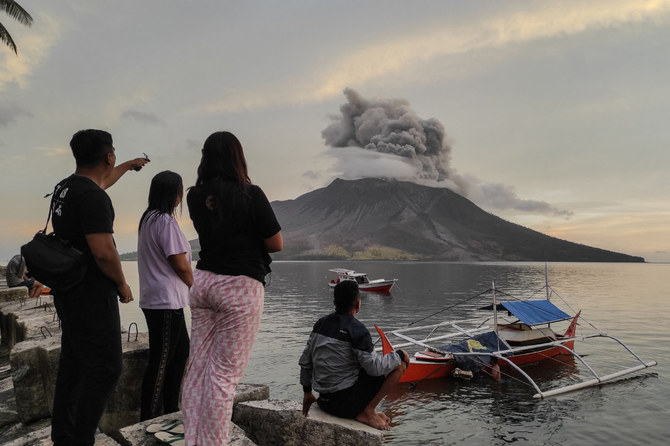
- Local authorities combed the villages surrounding the volcano and evacuated residents to safer areas by boat
- Officials worry that part of the volcano could collapse into the sea and cause a tsunami, as happened in an eruption there in 1871
MANADO, Indonesia: More than 2,100 people living near an erupting volcano on Indonesia’s Sulawesi Island were evacuated Friday due to the dangers of spreading ash, falling rocks, hot volcanic clouds and the possibility of a tsunami.
Indonesia’s Center for Volcanology and Geological Hazard Mitigation recorded at least three eruptions since Friday afternoon, with the maximum height of the eruption column reaching 1,200 meters (3,900 feet).
An international airport in Manado city, less than 100 kilometers (60 miles) from the erupting Mount Ruang, is still temporarily closed as volcanic ash was spewed into the air.
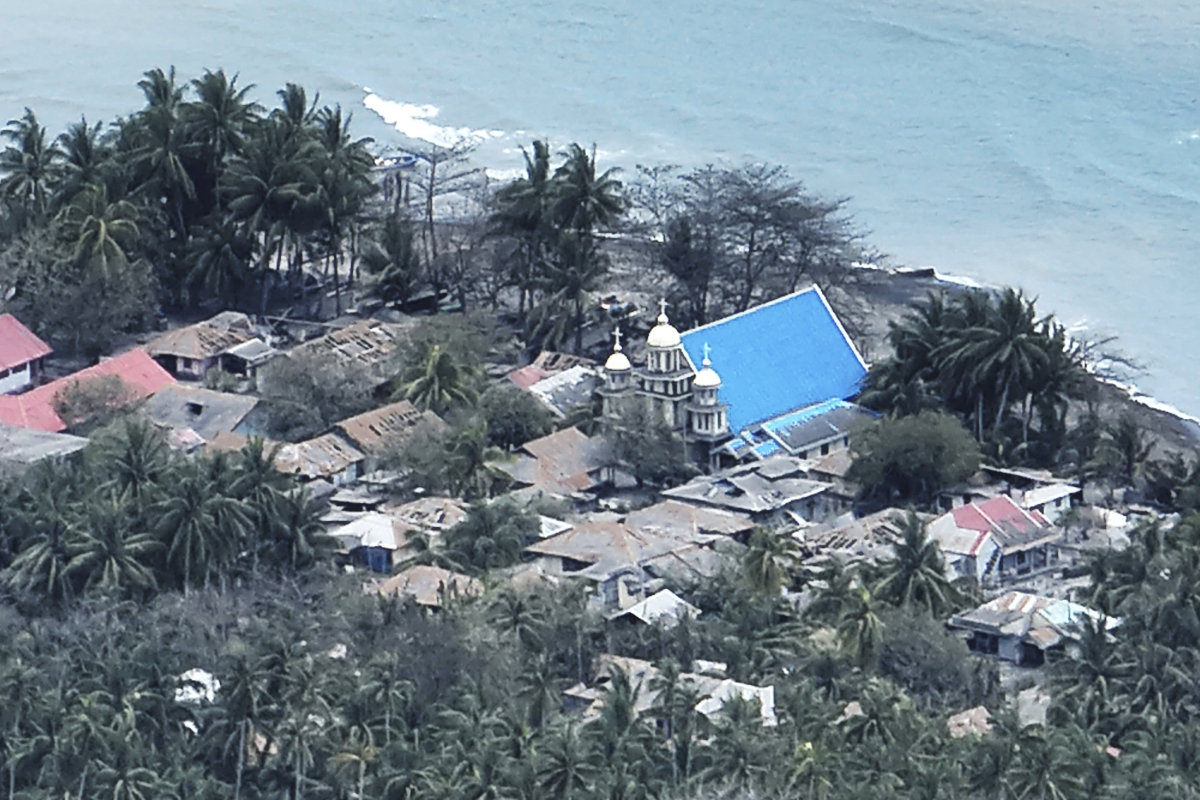
Satellite imagery from the Meteorology, Climatology and Geophysics Agency shows the ash has spread to the west, northwest, northeast and southeast, covering Manado and North Minahasa, according to a statement from Indonesia’s Transportation Ministry.
“We are still monitoring developments in the eruption of Mount Ruang and coordinating with relevant stakeholders … to anticipate the necessary actions to ensure flight safety, security and comfort,” said Ambar Suryoko, head of the regional airport authority.
More than 11,000 people were told to leave their homes that were located in the affected area. A joint team from the local authorities combed the villages surrounding the volcano and evacuated residents to safer areas by boat.
Officials worry that part of the volcano could collapse into the sea and cause a tsunami, as happened in an eruption there in 1871.
Houses, roads and other buildings were covered by gray volcanic ash, and many roofs were broken by debris spewed from the eruption.

Mount Ruang saw at least five large eruptions Wednesday, causing the Center for Volcanology and Geological Hazard Mitigation to issue its highest level of alert. People were ordered to stay at least 6 kilometers (3.7 miles) from the 725-meter (2,378-foot) mountain.
The observation from the agency on Friday said white smoke was rising from the main crater with medium to thick intensity.
East of the volcano, Tagulandang Island could be at risk if a collapse occurred. Its residents were among those being told to evacuate. Indonesia’s National Disaster Mitigation Agency said residents would be relocated to Manado, a journey of 6 hours by boat.
Indonesia, an archipelago of 270 million people, has 120 active volcanoes. It is prone to volcanic activity because it sits along the “Ring of Fire,” a horseshoe-shaped series of seismic fault lines around the Pacific Ocean.




